 This picture is courtesy of Eyal who's" jewishlayout" site is full of Magen Davids.
This picture is courtesy of Eyal who's" jewishlayout" site is full of Magen Davids.
Sunday, December 17, 2006
Protest
 This MagenDavid is made of stickers protesting against huge building corporations that try to evacuate tenants without paying them enough. The translation of the name of the organization behind this sticker is Organization of Neighbourhood Victims and its office is in Tel Aviv.
This MagenDavid is made of stickers protesting against huge building corporations that try to evacuate tenants without paying them enough. The translation of the name of the organization behind this sticker is Organization of Neighbourhood Victims and its office is in Tel Aviv. Picture is courtesy of "experimentalbiografie" who published it on Flickr.
Click to see more:
logo
Philosophical Implications
The following paragraph is from a new chapter, The Time Space Correlation, which doesn’t appear on Dr. Asher Eder’s book The Star of David, which was published in 1987 in English in Jerusalem by Rubin Mass Ltd.
Philosophical implications
"What is straight?" As soon as we become aware that each line in our universe, even this short one: ––––––––––– of one inch length, is in fact an arc (notwithstanding the infinite smallness of its bend), the following questions arise:
"Is there anything straight in geometry and elsewhere?";
"What is straight(ness) altogether?";
"Since there are no absolute straight lines in the material universe, could there be absolute
straightness on the level of morals and ethics?"
The initial question "what is straight" may seem irrelevant in view of the short line of one inch, but what about the connecting lines between Rome and Moscow, or Washington and Beijing, or Tokyo and Sydney, etc? Every pilot knows that on these long distant flights he does not fly a straight line but an arc in accordance with the shape of the globe.
Likewise in ethics and morals. In our daily affairs it seems to us rather clear what is straight, and what is not. On a bigger scale, however, we should not simply start out "just straight ahead". If doing so, we would most likely miss the mark. Like the pilot for his long distant flight, we need very accurate and detailed instructions guiding us to our destination. We find such instructions in the Torah, that is, the Divine Instruction of our Creator and Maker. In this context it is important to realize that the Torah is based upon the dynamic principle, and not upon the mechanistic or static one. Evidence thereof we find in its whole concept as well as in many passages, yet foremost in the Divine Name itself: "I'll be that I'll be" (the common translation "I am that I am" is incorrect, perhaps due to a static, mechanistic world view).
Throughout history, from Nimrod the founder of Babel, down to Hitler and Stalin, many people tried to follow what deemed straight in their own eyes. They failed, and wrought havoc. That shows that the term straight in its moral and ethical sense should be understood from the perspective of our Divine destination and the shortest and safest way towards it, and not from our own projections. This holds true for the matters of our daily lives as well, from the kind and quantity of food we take via the work and business we do up to decisions in leading positions. With this point in view, the Torah enjoins:
"There is a way which seemeth right (lit. straight) unto a man but the end thereof is the way to death" (Prov. 14:12; 16:25).
Therefore, "You shall not do every man whatsoever is right (liter. straight) in his own eyes ... you shall do which is right (liter. straight) in the eyes of the Lord thy God" (Deut. 12:8; 13:19).
Singing probably in this train of thought, King David said: "... He leads me in the circuits of righteousness [ מעגלי צדק ] for his name's sake" (Ps. 23:3). The word circuits here indicates the circumference set by the Torah, but also hints at the beneficial flow of energy welling in the Torah's circuits. The Creator in his infinity both encompasses these circles and is the center thereof - as shown in our graph. We humans, created in his image, may try to imagine him and his laws of creation, but cannot fully comprehend either.
As scientists are learning more and more to ask their questions not against nature (as taught by Francis Bacon, and others) but in accordance with the nature of the things in order to get a valid answer, likewise should we learn in view of our relations with our surroundings to look at things not from the angle of our own ideas and ideals (as straight as they may look) but from the point of the Divine, the Eternal, the Creative Life Force. As there are no contradictions between the Divine revelation and true science, the return to the original Hebrew Bible, i.e. the Tanakh, and its kabbalistic foundation would be very conducive to this end. It would be truly enlightening, and beneficial as well.
Click to see more:
Doctor Asher Eder
Subscribe to:
Comments (Atom)